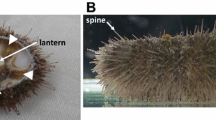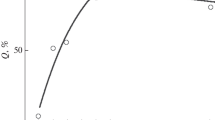Abstract
We studied swimming of goldfish fries about 3 cm long in a narrow channel by calculating the numbers of spontaneous turns on different sides. The ratio of fishes preferring to turn to the right vs to the left was 1.5:1.0, respectively; two-thirds of the fishes demonstrated an ambilateral behavior. Experiments with compulsory 10-min-long rotation of the fishes (clockwise around the longitudinal body axis for fishes preferring right-side turns and anticlockwise for fishes preferring left-side turns) showed that the behavioral asymmetry smoothed somewhat after such a procedure, and a greater number of the fishes became ambilateral in their preference to turn to one side or another. After a one- or two-day-long test, the initial asymmetry of motor behavior completely recovered. Compulsory rotation of similar fishes in the opposite direction exerted no influence on the asymmetry in the choice of the turning direction. Adaptation-induced training of the fishes (using fatiguing long-lasting vestibular stimulation) resulted in some smoothing of motor asymmetry but did not change its general pattern. Thus, our findings allow us to believe that a noticeable proportion of the goldfish individuals (similarly to other animals and humans) is characterized by an innate asymmetry of the motor function with a clear preference for either right- or left-side turnings. These relations can be smoothed under experimental influences but are recovered later on, i.e., they are stable and are not fundamentally transformed. We assume that the asymmetry of motor behavior of fishes in a narrow channel can be an adequate pre-requisite for further examination of the asymmetry of the brain and motor centers controlling changes in locomotion (body turnings)
Similar content being viewed by others
REFERENCES
J. S. Vinogradova, “Neuroscience at the end of the second millennium: A change of the paradigms,” Zh. Vyssh. Nerv. Deyat., 50, No.5, 743–774 (2000).
A. M. Thomson, “Facilitation, augmentation and potentiation at central synapses,” Trends Neurosci., 23, No.7, 305–312 (2000).
R. Yuste and W. Denk, “Dendritic spines as basic units of synaptic integration,” Nature, 375, No.6533, 682–684 (1995).
C. Salas, C. Broglio, and F. Rodrigues, “Evolution of forebrain and spatial cognition in vertebrates: Conservation across diversity,” Brain, Behav., Evolut., 62, 72–82 (2003).
V. L. Bianki, Asymmetry of the Animal Brain [in Russian], Nauka, Leningrad (1985).
H. Kleerekoper, A. M. Timms, G. F. Westlake, et al., “Inertial guidance system in the orientation of the goldfish (Carassius auratus),” Nature, 223, No.5205, 501–502 (1969).
S. D. Glick, T. P. Jerussi, and B. Zimmerberg, “Behavioral and neuropharmacological correlates of nigrostriatal asymmetry in rats,” in: Lateralization in the Nervous System, S. Harnad, R. W. Doty, L. Goldstein, et al. (eds.), New York (1977), pp. 213–249.
A. Pascual, K.-L. Huang, J. Neveu, and T. Preat, “Brain asymmetry and long-term memory,” Nature, 427, No.6975, 605 (2004).
S. I. Gleizer, “Functional dissymmetry in fishes,” Zh. Vyssh. Nerv. Deyat., 31, Issue2, 431–434 (1981).
Functional Interhemisphere Asymmetry [in Russian], N. N. Bogolepov and V. F. Fokin (eds.), Nauchnyi Mir, Moscow (2004).
D. A. Moshkov, Adaptation and Ultrastructure of the Neuron [in Russian], Nauka, Moscow (1985).
D. A. Moshkov, I. Ya. Podol’skii, L. A. Kashapova, et al., “Quantitative characteristics of the motor activity of the goldfish, Carassius auratus, as a possible indicator of the state of Mauthner neurons,” Zh. Evol. Biokhim., 18, No.2, 155–160 (1982).
D. A. Moshkov, I. M. Santalova, N. R. Tiras, et al., “Interaction of two different sensory inputs at the level of Mauthner neurons in goldfish: morphofunctional analysis,” in: Signal Molecules and Behavior, W. Winlow, O. S. Vinogradova, and D. A. Sakharov (eds.), Manchester Univ. Press, Manchester, New York (1991), pp. 199–204.
D. A. Moshkov, L. L. Pavlik, R. N. Tiras, et al., “Ultrastructural changes in the mixed synapses of Mauthner neurons related to long-term potentiation and natural modification of the motor function,” Neurophysiology/Neirofiziologiya, 35, No.5, 361–370 (2003).
S. J. B. Butt, J. M. Lebret, and O. Kiehn, “Organization of left-right coordination in the mammalian locomotor network,” Brain Res. Rev., 40, Nos.1/3, 107–117 (2002).
K. S. Liu and J. R. Fetcho, “Laser ablations reveal functional relationships of segmental hindbrain neurons in zebrafish,” Neuron, 23, No.2, 325–335 (1999).
R. N. Tiras, I. B. Mikheeva, P. I. Pakhotin, and D. A. Moshkov, “Morphofunctional modifications of the adapted Mauthner neurons of the goldfish after long-term orthodromic stimulation of the acoustic nerve in vitro,” Morfologiya, 122, Issue6, 19–24 (2002).
J. Nissanov, R. C. Eaton, and R. DiDomenico, “The motor output of the Mauthner cell, a reticulospinal command neuron,” Brain Res., 517, Nos.1/2, 88–98 (1990).
N. V. Markinas, O. V. Perepelkina, I. L. Plekhanova, et al., “Asymmetry of behavior and brain morphology in mice selected for heavy or light brain weight,” in: Urgent Question of Functional Interhemisphere Asymmetry (May 26–28, 2003) [in Russian], Moscow (2003), p. 70.
O. Gunturkun, “Adult persistence of head-turning asymmetry,” Nature, 421, No.6924, 711 (2003).
G. P. Udalova and A. Ya. Karas’, “Comparative analysis of spatial motor asymmetry in vertebrates,” in: Urgent Question of Functional Interhemisphere Asymmetry (May 26–28, 2003) [in Russian], Moscow (2003), pp. 316–317.
V. A. Geodakyan, “Asynchronous asymmetry,” Zh. Vyssh. Nerv. Deyat., 43, Issue3, 543–561 (1993).
V. F. Fokin and N. V. Ponomareva, Energetic Physiology of the Brain [in Russian], Antidor, Moscow (2003).
R. A. Sadekov and M. I. Vendrova, “Motor asymmetry and interhemisphere interaction in Parkinson’s disease,” Zh. Nevrol. Psikhiat., No. 1, 42–46 (2004).
H. van Praag, B. R. Christie, T. J. Sejnowski, and F. H. Gage, “Running enhances neurogenesis, learning, and long-term potentiation in mice,” Proc. Natl. Acad. Sci. USA, 96, No.23, 13427–13431 (1999).
S. G. Sarkisyan, M. L. Egiazaryan, and S. M. Minasyan, “Asymmetry of characteristics of the background activity of neurons of the medial vestibular nucleus in rats after long-term vibrational stimulation,” Neirofiziologiya/Neurophysiology, 35, No.6, 470–475 (2003).
T. Preuss and D. S. Faber, “Central cellular mechanisms underlying temperature-dependent changes in the goldfish startle-escape behavior,” J. Neurosci., 23, No.13, 5617–5626 (2003).
Y. Oda, K. Kawasaki, M. Morita, et al., “Inhibitory long-term potentiation underlies auditory conditioning of goldfish escape behavior,” Nature, 394, No.6689, 182–185 (1998).
D. S. Faber, J. R. Fetcho, and H. Korn, “Neuronal networks underlying the escape response in goldfish: general implications for motor control,” Ann. New York Acad. Sci., 563, 11–33 (1989).
Author information
Authors and Affiliations
Corresponding authors
Additional information
Neirofiziologiya/Neurophysiology, Vol. 37, No. 1, pp. 52–60, January–February, 2005.
Rights and permissions
About this article
Cite this article
Mikhailova, G.Z., Arutyunyan, A.V., Santalava, I.M. et al. Asymmetry of Motor Behavior of the Goldfish in a Narrow Channel. Neurophysiology 37, 48–55 (2005). https://doi.org/10.1007/s11062-005-0044-0
Received:
Issue Date:
DOI: https://doi.org/10.1007/s11062-005-0044-0




